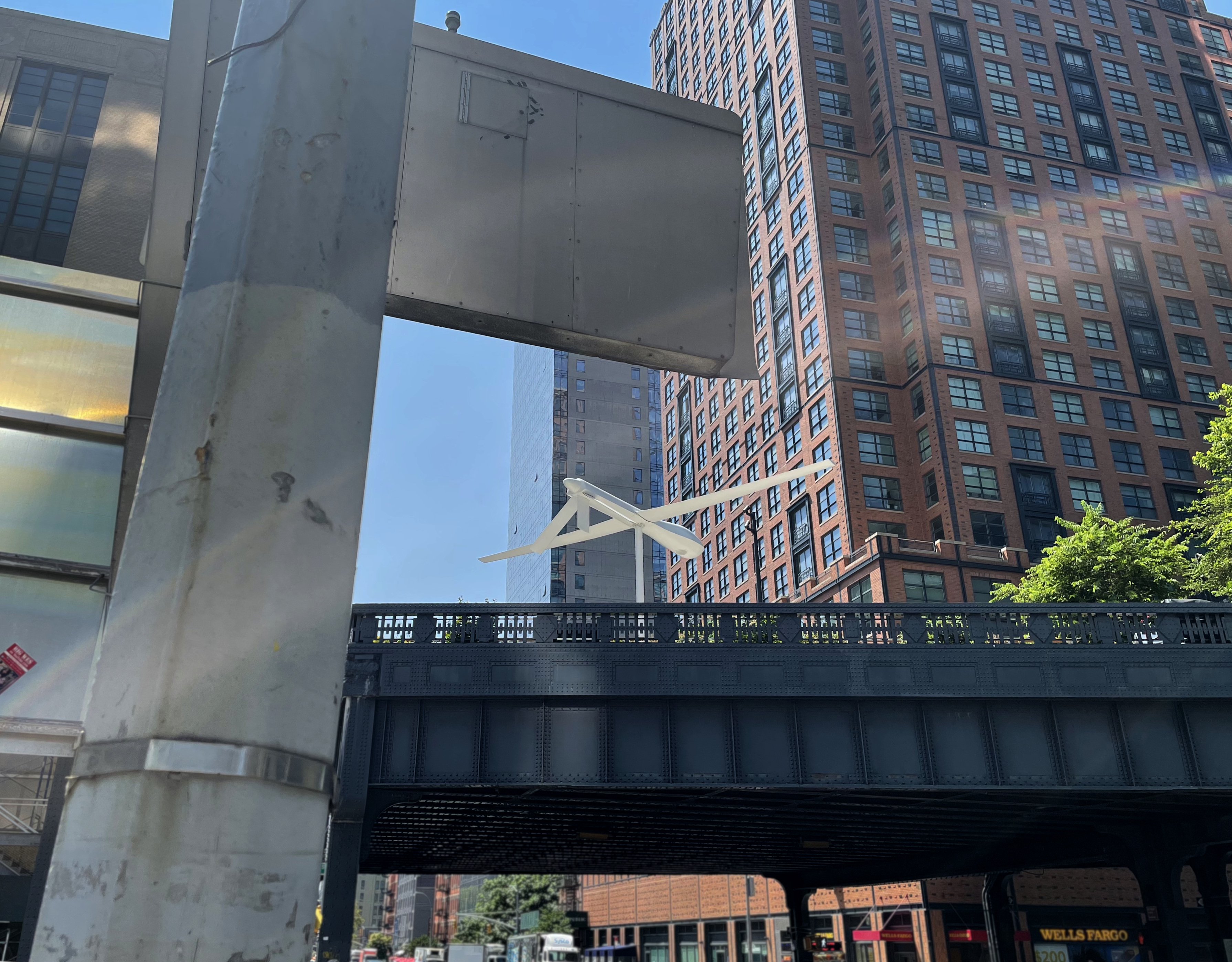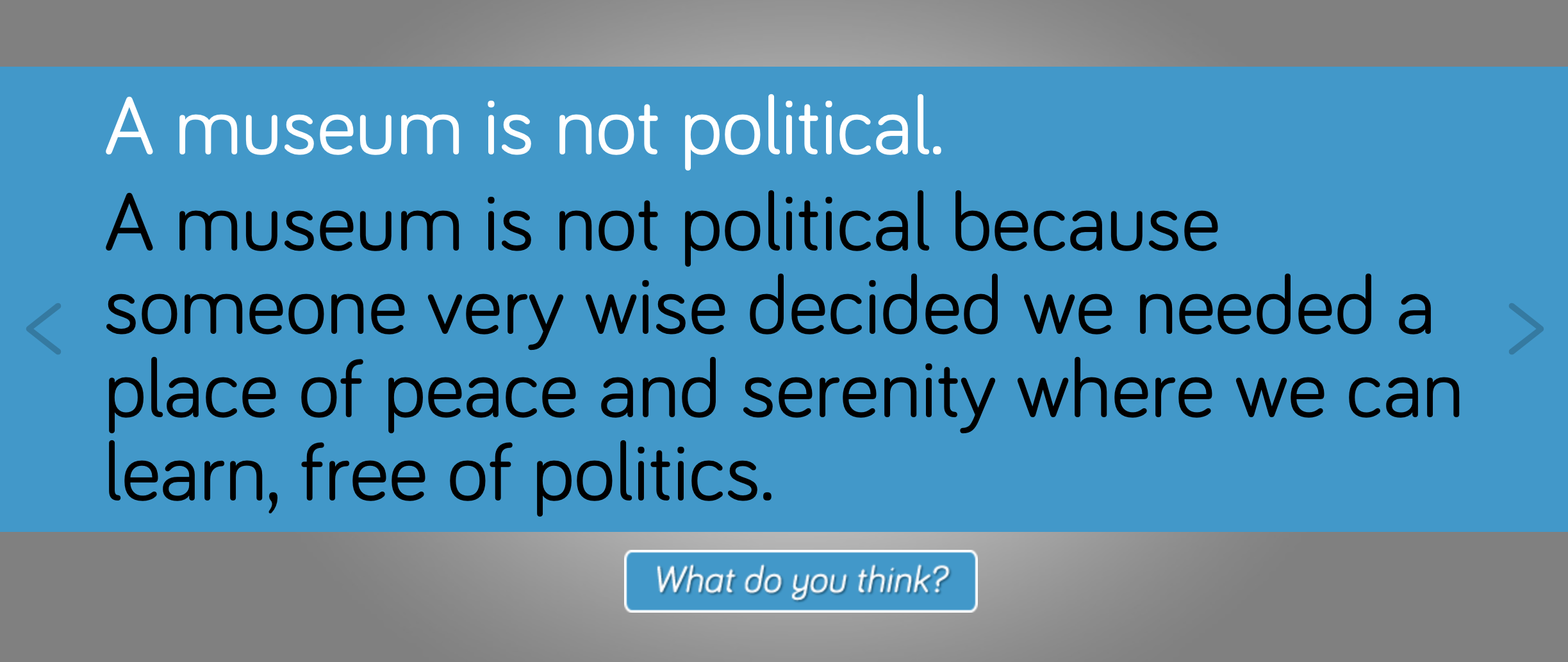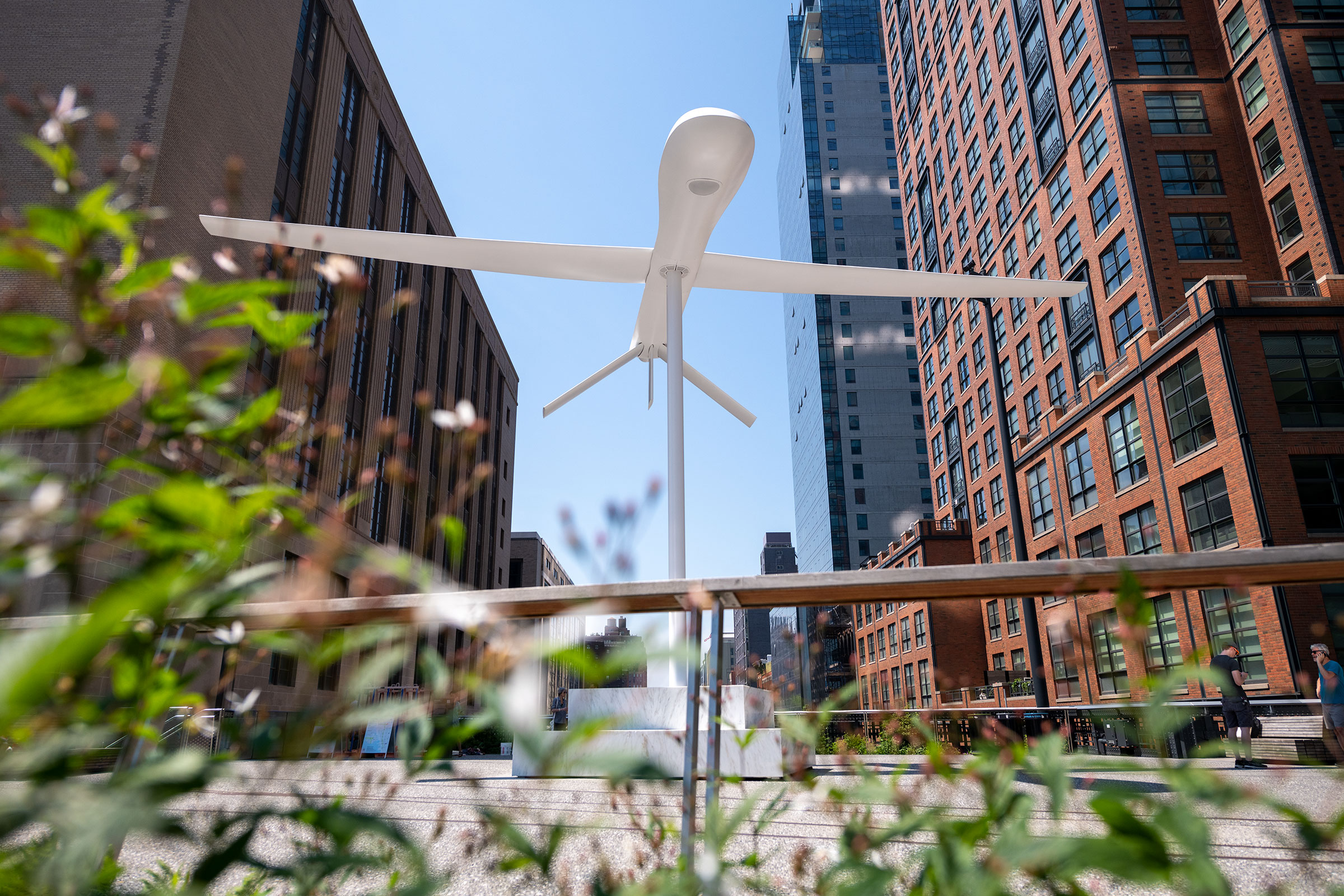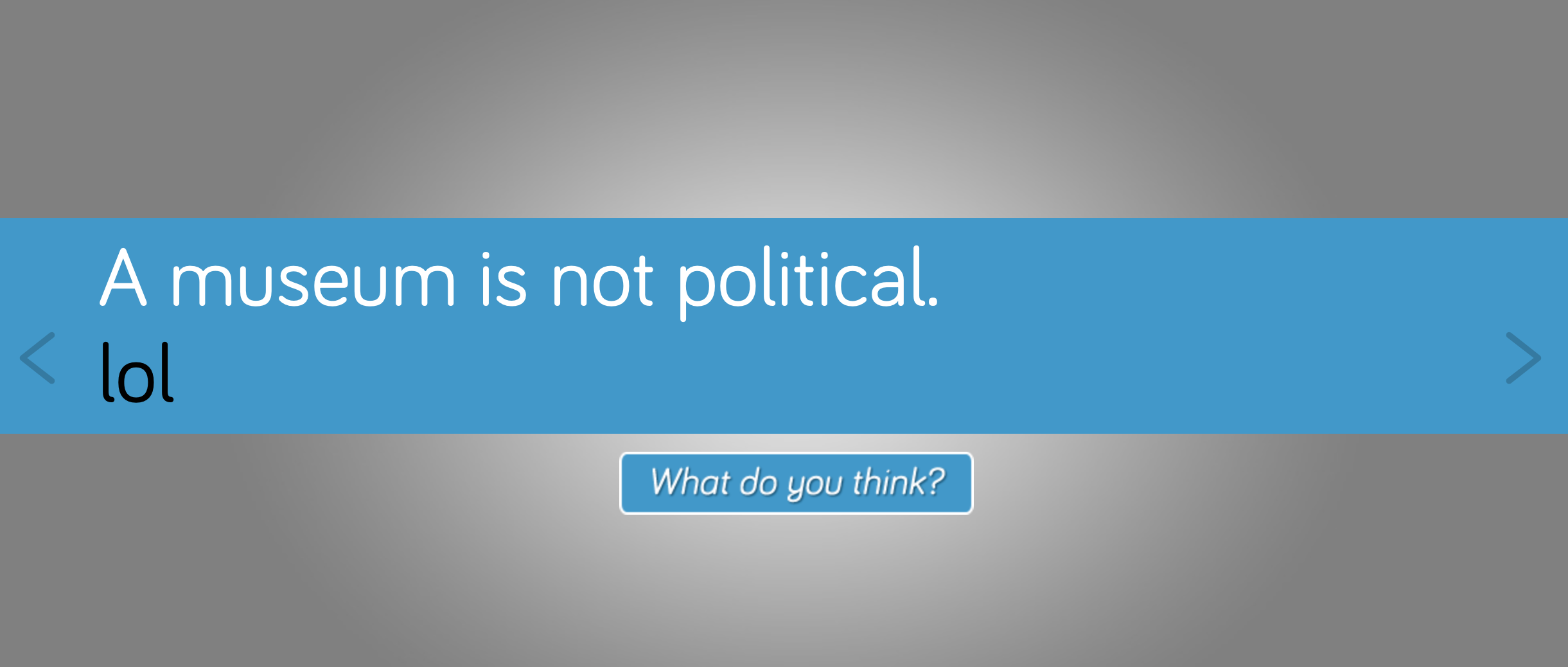The Dash column explores art and its social contexts. The dash separates and the dash joins, it pauses and it moves along. The dash is where the viewer comes to terms with what they’ve seen. Here, X-TRA editor Travis Diehl discusses Untitled (drone) (2016–2021), a menacing new public artwork by Sam Durant, installed on the High Line Plinth in New York through August 2022.

Sam Durant, Untitled (drone), 2016–2021. High Line Plinth, New York, May 28, 2021–August 31, 2022. Photo: Travis Diehl.
In 2013, Sam Durant was tapped by the Getty for a social media campaign aimed at a public apparently intimidated by art museums. The idea was to probe our idea of what museums “are” or “could be” through hashtagged prompts: #isamuseumfun? #isamuseumaschool? #isamuseumforeveryone? The rollout began around the tenth anniversary of the US invasion of Iraq, and in this context, a friend and I had a running joke: to exchange “museum” for “drone” in Durant’s wan slogans (#isadronetruthful?, #isadronepolitical?, #isadroneforeveryone?), because really—when regular people are dying senselessly, uncounted, as the collateral damage of our foreign wars—who cares what our public, thusly sheltered, thinks #isamuseum.

Anonymous response on the What #isamuseum? website, c.2017. Screenshot.
Then, this June, like the consummation of a prophecy, Sam Durant debuted Untitled (drone) (2016–21). The sculpture, a selection for the High Line Plinth in New York and his first major public outing since the Scaffold controversy, is a full-size fiberglass mockup of a Predator drone, looming over six lanes of traffic from a spur of the elevated park at 30th Street and 10th Avenue on a diminutive 25-foot stalk. The actual Predator operates at 25,000 feet, making Durant’s replica something like a thousand times optically larger than the real thing, which is practically invisible at cruising altitude, sometimes audible as a faint buzz. Other than this, the artist’s interventions include redacting the landing gear and missiles from the airframe, abstracting the plane just enough for the PR to claim that maybe Durant’s drone evokes Brancusi. The latter’s L’Oiseau dans l’espace (Bird in Space, 1923–1941—versions of which are held uptown at MoMA, the Met, and the Guggenheim) is popularly a celebration of modernity, of powered flight, or motion studies, or just abstraction in general, and the leap to a critique of Modernism’s ties to the war machine seems implausible. But the impulse is there, as if Durant’s sculpture could formally pantomime the threat of drone warfare as we inflict it on others, while somehow, perhaps through sheer ham-fistedness, flagging the willful oblivion of this terror campaign in the popular imagination.

Sam Durant, Untitled (drone), 2016–2021. High Line Plinth, New York, May 28, 2021–August 31, 2022. Courtesy of the High Line. Photo: Timothy Schenck.
Drone looks like a drone, but, although an early video shows Durant studying a maquette of a Reaper, the Predator is an old model, a symbolic first. This is not the only way the sculpture is an Obama-era relic. The High Line Plinth shortlist was announced in 2016, meaning Durant likely conceived the project before the reality of a Trump presidency had metastasized, and likely assumed (hoped?) that drone would darken the neoliberal skies of a Hillary Clinton regime. This invective was immediately outmoded by the peaceful transfer of power from the country’s first Black president to its next racist white one. Suddenly, Trump, awful in every way, claimed to want to quit the Middle East, quickening the pace of air-to-surface killings all the while, and chiding Obama’s bashful escalation of the drone wars seemed beside the point. In the meantime, in 2018, the Predator was retired from service. But here is Durant’s drone at last, installed during Joe Biden’s first year and once again edgy in comparison to the beatitudes of business as usual—which tells you something about what a milquetoast condemnation drone would be under any US president, how pitiful and cordial a certain idea of political public art has become or perhaps always was. The Disneyfied doom of drone isn’t scary. Its ridiculous truism is. I’d like to think Durant meant his High Line drone to operate this way, as banality on a stick, a Capitoline goose by which future archaeologists will try to reconstruct the slick death and soul rot of our vanished empire. It won’t tell you, if you don’t already know, that while you’re licking an ice cream sandwich in the hectic safety and expense of an Edenic railbed in upper Chelsea—even then—the United States is launching extralegal assassinations in Africa.

Anonymous response on the What #isamuseum? website, c.2017. Screenshot.
The laws of war, such as they are, hang on intent. Latter day drone warfare is conducted in careful legalese, lawyers in the room witnessing every button press and order, annotating the military intent to kill combatants only. What difference does this intent make on the ground? Pitifully little. None at all. Bear with me, but the same is true of art.
Durant has said that he addresses his explorations of white crimes to a white audience. This is necessary, as white people must work to undo white supremacy, and this includes countering the dehumanizing jargon of “signature strikes” and “bug splats” supporting drone violence—yet also naïve, as it overlooks the lived reality of non-white viewers (Scaffold, again). New York is a diverse city, even if Chelsea skews rich and white. The paratext around drone (unlike that of Scaffold) has been thoroughly vetted. On the High Line Spur, in drone’s shadow, a gem-shaped set of didactic panels asks: “What Is A Drone?” and “Who flies drones?” and tells you how you can “Learn More About Drones,” offering a free booklet. It’s almost as if Durant believes that this cache of information, this didactic trap to the sculpture’s lure, is the real work. The didactics, compiled by a team of experts from NGOs and other organizations dedicated to justice for drone victims, the end of US imperialism, and the right to privacy, give a clear, wide-angle overview of the issue, including the domestic use of aerial surveillance in Baltimore, Saint Louis, and New York City, tying those technologies to the death-dealing robots even now circling over Afghanistan and Iraq. But the problem of audience remains. Durant’s sculpture would likely read in Quantico, Virginia as a sort of positive monument, as much as it reads in Manhattan as a sick joke or a misguided statement of liberal, left-wing principles, mired in the abstract idioms of modern art. A drone on a pole tells you nothing in itself, and the information it delivers is similarly neutral, context-dependent. The artist’s intent gets lost along the wire. Durant wields the language of public art and signage to post a political stance—anti-racist, anti-war, anti-imperialist—but is led by the broad unknowability of his public to over-polish the message, until one wonders what the point was in the first place.

Anonymous response on the What #isamuseum? website, c.2017. Screenshot.
There’s a tragic aspect (though tragic is too strong a word) to political art in public, reduced to the simple yearning that any audience is audience enough. It’s a technocratic double bind, where only the bluntest measures might reach enough minds to, as they say, make a difference. So why do artists keep leaning in to technocracy? It’s almost incumbent here to describe US missiles lancing wedding parties and daycares, since the absence of this carnage is ultimately what drone elicits, and anything less would be to accept its euphemism, the illusion of clean, smart, precision warfare waged from the sky against the blank unpeopled canvas overseas.
A screaming comes across the sky. The US-made munitions fall alike on Boko Haram and Hamas. The uncalloused hands on the joysticks in Langley change in shifts, and the vigilant eye of the state stays peeled. Imagine a version of drone, call it an audio component, an off-site extension of the piece, where at unspecified times, in unspecified places, desert drives or bachelorette parties or dreamless nights, drone makes the sound of a supersonic Hellfire missile leaving its pylon miles above. Say it’s a reference to Robert Morris’s Box with the Sound of Its Own Making (1961). Call it, War Crime with the Sound of Its Own Making. Hear it? No? Exactly. That’s the point. x

Travis Diehl is Online Editor at X-TRA. He is a recipient of the Andy Warhol / Creative Capital Arts Writers Grant and the Rabkin Prize in Visual Art Journalism.